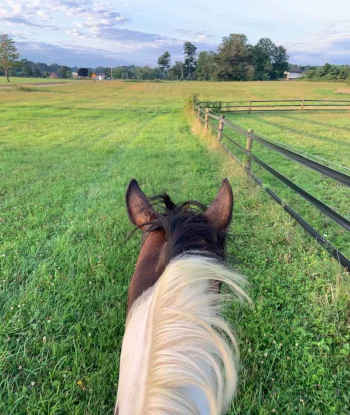By Bethany Bickel
Trail riding is a popular way to spend time outdoors enjoying nature, friendship, and your horse. Safety is first and foremost and should always be considered when riding on the trails. There are many considerations to keep in mind as you prepare to hit the trails.
- Have you checked your tack, equipment, and horse?
- Do you have a safety plan?
- If you are riding alone, did you tell someone where you were going, and when to expect your return?
These are a few of the many considerations and steps to take to ensure a safe and enjoyable ride for you and your horse.
Make a Plan
Plan your ride and route in advance. Make sure the area and trails allow horses. It is best to not ride alone; if you do, let someone know where you are going and when to expect you back. Even if you are riding with a group, it is good practice to let someone know where you are riding and when to expect the group back. Be aware of the wildlife you may encounter in the area and plan accordingly. Pennsylvania currently has seventeen state forests and thousands of miles of forestry roads, designated equestrian trails, and shared-use trails open to trail riding enthusiasts. For more information about horseback riding in Pennsylvania State Parks and Forests visit
Horseback Riding in State Parks and Forests.
When riding during early September through December keep in mind large and small game hunting seasons. In Pennsylvania, you may choose to limit your riding to Sundays which traditionally is the “day off” for hunting. Recent changes in hunting regulations by the Pennsylvania Game Commission now provide hunters with three select Sunday dates to hunt. These dates change from year to year. Reference the PA Hunting and Trapping Digest when planning a ride during these months.
Check your Tack and Equipment
Riding equipment should be clean and in good working condition, free of rot and frays. The saddle should fit you and your horse properly. It should not pinch the horse’s withers, shoulders, back or loin, and the girth should not pinch behind the horse’s elbow. Now is also a good time to make sure your stirrups are adjusted properly: the bottom of the stirrup should reach the ankle bone of the rider when the foot is out of the stirrup.
Other General Guidelines for Riding Safely on the Trail:
- Wear a properly fitted riding helmet. For more information on how to choose the proper design and fit for your riding needs visit our article How Hard is Your Head?
- Stay alert and be aware of your surroundings and watch for other horses acting up or situations that may frighten your horse.
- Always ride at the speed that is comfortable and safe for the least experienced rider in the group.
- Avoid riding away from other horses in the group, especially from a horse that has a buddy.
- Depending on temperament and experience of horses and riders in your group, you may ride abreast (shoulder to shoulder).
- Try to avoid horses that do not like your horse or vice versa.
- Wear bright colors during hunting seasons. A blaze-orange hunting vest, some are reversible, so you can wear a softer color other times of the year. Do not forget about your horse, consider a brightly colored halter, saddle bag, or plastic ribbon braided into their mane and/or tail.
Items to Consider Packing:
- Cell phone
- Health papers/Coggins Test
- Easy Boot *Good to have in case your horse has lost a shoe. No Easy Boot? No problem, a diaper, vet wrap and tape can be used.
- Map, compass, other GPS tracking
- Horse and human first aid kits
- Electrolytes
- Whistle *Less effort to use in an emergency.
- Snacks
- Sunscreen
- Water
- Halter/lead rope *Good to have in case bridle, reins, or bit breaks.
- Rain gear
- Gloves
- Hoof pick
- Multi-tool

Whether you are taking a short ride or a weekend trip, keep these safety guidelines in mind before you hit the trails.
Basic safety procedures and practices are essential in providing a safe and enjoyable experience for both you, your riding group, and your horse.
Happy Trails!